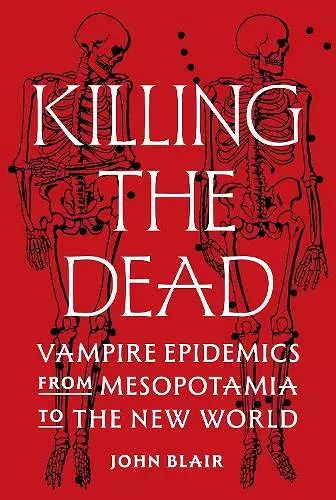Killing the Dead
Vampire Epidemics from Mesopotamia to the New World
Format:Hardback
Publisher:Princeton University Press
Published:9th Sep '25
Should be back in stock very soon

A riveting history of vampire panics across cultures and down through the millennia—and why killing the dead is better than killing the living
Killing the Dead provides the first in-depth, global account of one of the world’s most widespread yet misunderstood forms of mass hysteria—the vampire epidemic. In a spellbinding narrative, John Blair takes readers from ancient Mesopotamia to present-day Haiti to explore a macabre frontier of life and death where corpses are believed to wander or do harm from the grave, and where the vampire is a physical expression of society’s inexplicable terrors and anxieties.
In 1732, the British public opened their morning papers to read of lurid happenings in eastern Europe. Serbian villagers had dug up several corpses and had found them to be undecayed and bloated with blood. Recognizing the marks of vampirism, they mutilated and burned them. Centuries earlier, the English themselves engaged in the same behavior. In fact, vampire epidemics have flared up throughout history—in ancient Assyria, China, and Rome, medieval and early modern Europe, and the Americas. Blair blends the latest findings in archaeology, anthropology, and psychology with vampire lore from literature and popular culture to show how these episodes occur at traumatic moments in societies that upend all sense of security, and how the European vampire is just one species in a larger family of predatory supernatural entities that includes the female flying demons of Southeast Asia and the lustful yoginīs of India.
Richly illustrated, Killing the Dead provocatively argues that corpse-killing, far from being pathological or unhealthy, served as a therapeutic and largely harmless outlet for fear, hatred, and paranoia that would otherwise result in violence against marginalized groups and individuals.
"In this expansive volume, archaeologist Blair surveys stories of corpses rising from the dead, from classical Greece to the ‘corpse killing’ epidemics of the 17th century. . . . This meticulous account sheds horrifying light on the constancy with which women have been made to pay, even in death, for society’s larger anxieties." * Publishers Weekly, starred review *
"Wonderful stories. . . .Writers will no doubt continue to disinter the undead in their fiction. . . .Let this be their handbook."---Suzie Feay, The Spectator
"Blair is to be congratulated on having produced a masterfully lucid history, filled with originality and excitement. Every page of Killing the Dead bursts with fresh insights and deliciously gory details. And, like all the best vampires, it’ll come back to haunt you long after you think you’re done."---Alexander Lee, Literary Review
"Authoritative and compelling. . . .This fascinating history shows that you can't keep a good corpse down."---Roger Luckhurst, History Today
"Illuminating. . . . By bringing his archaeological focus to bear on the question [of how to deal with vampires], Blair unearths some puzzling continuities and raises the stakes."---Crawford Gribben, Wall Street Journal
"A fascinating cavalcade of stories."---Colin Dickey, Chronicle of Higher Education
ISBN: 9780691224794
Dimensions: unknown
Weight: unknown
536 pages